Abstract
Purpose
To analyze the effect of presence with or absent of retinopathy of prematurity (ROP) and its stage, birth weight, conceptual age and associated diseases on the axial length of premature infants' eye.
Methods
A total of 102 eyes of 51 premature infants less than 36 weeks of conceptual age were evaluated in this study. Fundus examination for ROP and axial length measurement were conducted at 40, 52 and 64 weeks of postconceptual age. The medical records were reviewed retrospectively. Independent t-test analysis, simple regression analysis, and one-way ANOVA were performed to assess the influence of each factor on axial length.
Results
The mean axial length at 40, 52 and 64 weeks were 17.35, 18.80 and 19.78 mm, respectively. The mean axial length with and without ROP at 40 weeks were 17.10 mm and 17.54 mm, respectively, which were statistically significant (p=0.000). There was a significant decrease in axial length at 40 weeks in the higher ROP stage (p<0.05). Axial length and birth weight showed positive correlation with statistical significance at 40 weeks, while these parameters showed no significant correlation at 64 weeks. Axial length and conceptual age showed a positive correlation with statistical significance at 40 weeks (p=0.000), yet a negative correlation at 64 weeks with no statistical significance (p=0.306). A significant difference was not observed between sex and the associated diseases.
References
1. Yamamoto Y. A new study on the measurement of ocular axial length by ultrasound echography. Acta Soc Ophthalmol Jpn. 1960; 64:1333–41.
2. Sorsby A, Leary GA, Richards MJ, Chaston J. A aberrations measurement of the components of ocular refraction in life. Vision Res. 1963; 3:499–506.
3. Larsen JS. The sagittal growth of the eye. I. Ultrasonic measurement of the depth of the anterior chamber from birth to puberty. Acta Ophthalmol. 1971; 49:239–62.
4. Larsen JS. The sagittal growth of the eye. IV. Ultrasonic measurement of axial length of the eye from birth to puberty. Acta Ophthalmol. 1971; 49:873–86.
5. Coleman DJ, Carlin B. A new system for visual axis measurements in the human eye using ultrasound. Arch Ophthalmol. 1967; 77:124–7.

6. Duke-Elder S. System of Ophthalmolgy. 2:The Anatomy of visual System. St. Louis: CV Mosby;1961. p. 80–1.
7. Villada JR, Raj PS, Akingbehin T. Calculation of the power of anterior chamber implants. Br J Ophthalmol. 1992; 76:303–306.

8. Youn DH, Yu YS, Park IW. Intraocular pressure and axial length in children. J Korean Ophthalmol Soc. 1990; 31:397–401.

9. Woo JM, Kim SJ, Jeong SK, Park YG. The influence of axial aberrations on the response to strabismus surgery. J Korean Ophthalmol Soc. 1997; 38:680–6.
10. Park HY, Park SW, Park YG. The study of axial length and functional equator in strabismus surgery. J Korean Ophthalmol Soc. 2005; 46:827–36.
11. Tarkkanen A, Uusitalo T, Mianowicz J. Ultrasonographic biometry in congenital glaucoma. Acta Ophthalmol. 1983; 61:618–23.

12. Page J, Schneeweissm Whyte H, Harvey P. Ocular sequelae in premature infants. Pediatrics. 1993; 92:787–90.

13. Choi MY, Park IK, Yu YS. Long term refractive outcome in eyes of preterm infants with and without retinopathy of prematurity: comparison of keratometric value, axial length, anterior chamber depth, and lens thickness. Br J Ophthalmol. 2000; 84:138–43.

14. American Academy of Pediatrics. Section on Ophthalmology. Screening examination of premature infants for retinopathy of prematurity. Pediatrics. 2001; 108:809–811.
15. Blomdahl S. Ultrasonic measurement of eye in the newborn infant. Acta Ophthalmol. 1979; 57:1048–56.
16. Gordon RA, Donzis PB. Refractive development of the human eye. Arch Ophthalmol. 1985; 103:785–91.

17. Cho KS, Shim YB, Kim BC. Interrelationship between axial length and refractive states, and anterior chamber depth in the newborn. J Korean Ophthalmol Soc. 1990; 31:215–9.
18. Harayama K, Amemiya T, Nishimura H. Development of the eyeball during fetal life. J Pediatr Ophthalmol Strabismus. 1981; 18:37–40.

19. Kim WJ, Park SH, Shin HH. The change f axial length according to age in the eyeball of premature infants by ultrasonic biometry. J Korean Ophthalmol Soc. 1993; 34:667–671.
20. Cook A, White S, Batterbury M, Clark D. Ocular growth and refractive error development in premature infants with or without retinopathy of prematurity. Invest Ophthalmol Vis Sci. 2008; 49:5199–207.

21. Fledelius HC, Jamsen EC, Thorn J. Refractive change during hyperbaric oxygen therapy. A clinical trial including ultrasound oculometry, Acta Ophthalmol Scand. 2002; 80:188–90.
Figure 7.
Relationship between birth weight and axial length in without ROP group. (AL: axial length)
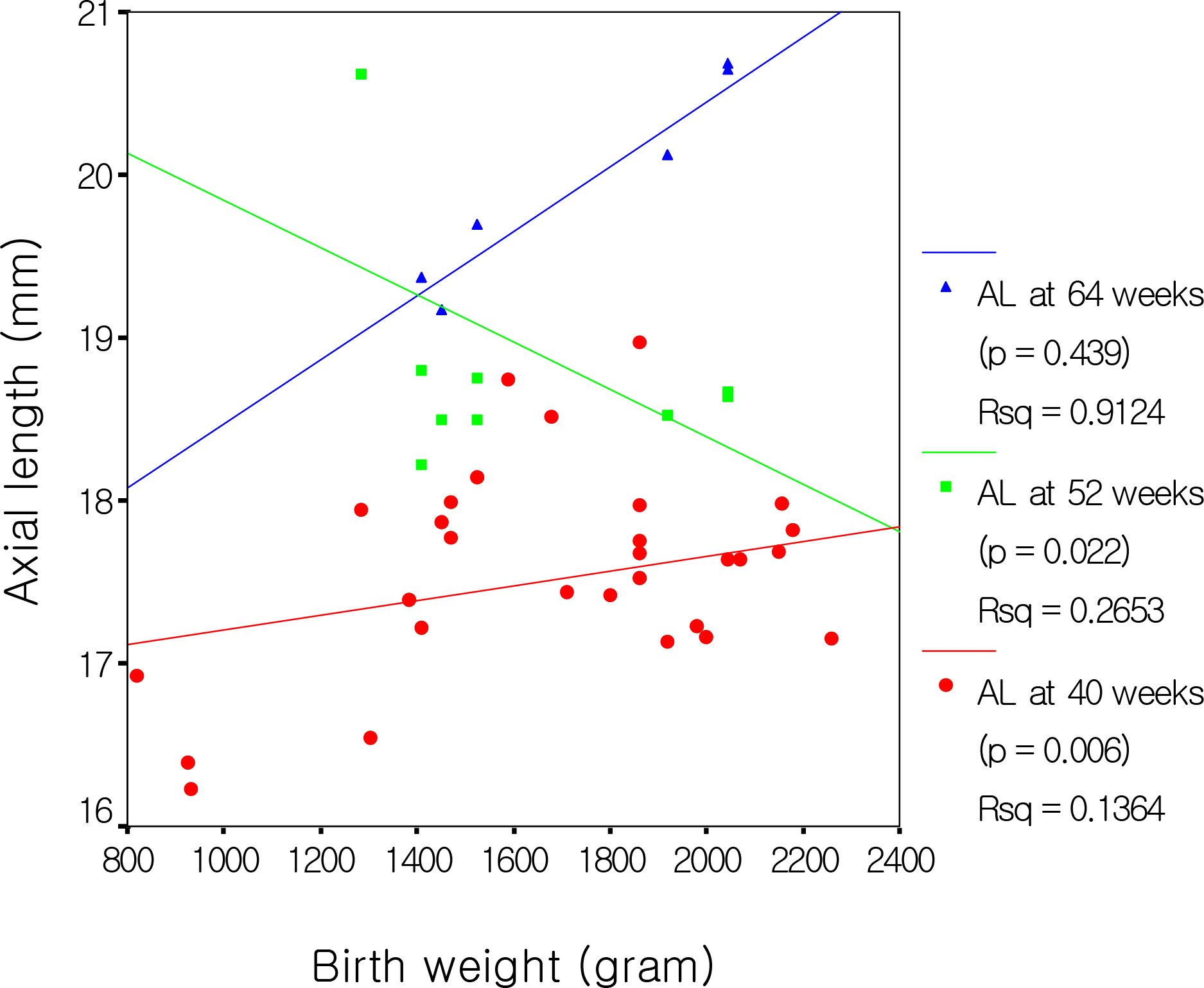
Figure 8.
Relationship between conceptual age and axial length in without ROP group. (AL: axial length)

Table 1.
Patient data
| | N* | Mean ± SD† (range) |
|---|---|---|
| Birth age (weeks) | 102 | 30.59±2.8 (24.71–35.86) |
| Birth weight (gram) | 102 | 1495.45±511.66 (680–3260) |
| Anterior chamber at 40week (mm) | 102 | 2.23±0.19 (2.02–2.77) |
| Male | 44 | 43.14% |
| Female | 58 | 56.86% |
| With ROP‡ | 54 | 52.94% |
| Without ROP | 48 | 47.06% |
| Associated disease | 31 | 61% |
| Respiratory distress syndrome | 16 | 52% |
| Intraventricular hemorrhage | 3 | 10% |
| Necrotizing enterocolitis | 1 | 3% |
| Bronchopulmonary dysplasia | 3 | 10% |
| More than 2 Diseases | 8 | 26% |
Table 2.
Factors affecting axial length of premature infant's eye
| | Factor |
At 40 weeks |
At 52 weeks |
At 64 weeks |
|||
|---|---|---|---|---|---|---|---|
| N | Axial length (mm) | N | Axial length (mm) | N | Axial length (mm) | ||
| Sex | Male | 58 | 17.38 | 24 | 18.84 | 20 | 19.85 |
| Female | 44 | 17.31 | 18 | 18.74 | 14 | 19.62 | |
| p-value | | 0.564 | | 0.626 | | 0.649 | |
| ROP* | Absence | 54 | 17.54 | 12 | 18.24 | 10 | 19.80 |
| Present | 48 | 17.13 | 30 | 18.62 | 24 | 19.77 | |
| p-value | | 0.000* | | 0.006* | | 0.913 | |
| Associated diseases | Absence | 40 | 17.32 | 20 | 18.72 | 16 | 19.92 |
| Present | 62 | 17.36 | 22 | 18.87 | 18 | 19.65 | |
| p-value | | 0.725 | | 0.496 | | 0.220 | |
| Associated Diseases number | 1 Disease | 42 | 17.32 | 16 | 18.94 | 10 | 19.63 |
| More than 2 disease | 22 | 17.37 | 8 | 18.56 | 8 | 19.68 | |
| p-value | | 0.735 | | 0.283 | | 0.885 | |
| Respiratory disease | Absence | 48 | 17.31 | 22 | 18.81 | 20 | 19.96 |
| Present | 54 | 17.40 | 20 | 18.79 | 14 | 19.52 | |
| p-value | | 0.455 | | 0.937 | | 0.243 | |
Table 3.
Mean anterior chamber depth and axial length
| | N* | Mean | SD† | Min | Max |
|---|---|---|---|---|---|
| Anterior chamber at 40 weeks | 102 | 2.23 | ±0.19 | 2.02 | 2.77 |
| Anterior chamber at 52 weeks | 42 | 2.58 | ±0.22 | 2.11 | 2.95 |
| Anterior chamber at 64 weeks | 34 | 2.81 | ±0.22 | 2.37 | 3.10 |
| Axial length at 40 weeks | 102 | 17.35 | ±0.61 | 16.12 | 18.97 |
| Axial length at 52 weeks | 42 | 18.80 | ±0.68 | 17.6 | 20.62 |
| Axial length at 64 weeks | 34 | 19.78 | ±0.63 | 18.78 | 21.18 |
Table 4.
Summary statistics, each time point, for stage of ROP
| Parameter | Stage of Rop | n* |
40 weeks |
52 weeks |
64 weeks |
|||
|---|---|---|---|---|---|---|---|---|
| mean | SD† | mean | SD | mean | SD | |||
| ACD‡ (mm) | 0 | 54 | 2.23 | ±0.21 | 2.63 | ±0.22 | 2.79 | ±0.22 |
| 1 | 34 | 2.26 | ±0.19 | 2.51 | ±0.23 | 2.72 | ±0.20 | |
| 2 | 10 | 2.17 | ±0.08 | 2.62 | ±0.16 | 2.85 | ±0.18 | |
| 3 | 4 | 2.11 | ±0.06 | 2.52 | ±0.05 | 2.69 | ±0.02 | |
| AL§ (mm) | 0 | 54 | 17.54 | ±0.61 | 18.94 | ±0.84 | 19.8 | ±0.57 |
| 1 | 34 | 17.22 | ±0.47 | 18.66 | ±0.56 | 19.75 | ±0.65 | |
| 2 | 10 | 17.08 | ±0.64 | 18.76 | ±0.23 | 19.91 | ±0.75 | |
| 3 | 4 | 16.48 | ±0.02 | 18.52 | ±0.07 | 19.27 | ±0.14 | |
Table 5.
Axial length in preterm infants who require ROP screening examination
| |
At 40 wks |
At 52 wks |
At 64 wks |
||||||||
|---|---|---|---|---|---|---|---|---|---|---|---|
| N | Axial length (mm) | SD† | N | Axial length (mm) | SD | N | Axial length (mm) | SD | |||
| All | Birth weight | ≥1500 | 48 | 17.63 | ±0.55 | 12 | 18.68 | ±0.49 | 10 | 20.13 | ±0.50 |
| (gram) | <1500 | 54 | 17.09 | ±0.54 | 31 | 18.76 | ±0.62 | 26 | 19.60 | ±0.61 | |
| | (p-value) | | 0.000‡ | | | 0.673 | | | 0.021‡ | | |
| Conceptual | ≥28 | 82 | 17.44 | ±0.61 | 25 | 18.71 | ±0.72 | 20 | 19.68 | ±0.60 | |
| age(week) | <28 | 22 | 17.01 | ±0.48 | 18 | 18.77 | ±0.32 | 16 | 19.83 | ±0.66 | |
| | (p-value) | | 0.003‡ | | | 0.736 | | | 0.465 | | |
| Without ROP | Birth weight | ≥1500 | 36 | 17.63 | ±0.55 | 6 | 18.60 | ±0.10 | 6 | 20.15 | ±0.44 |
| (gram) | <1500 | 18 | 17.09 | ±0.54 | 5 | 19.35 | ±1.18 | 4 | 19.26 | ±0.12 | |
| | (p-value) | | 0.002‡ | | | 0.226 | | | 0.003‡ | | |
| Conceptual age | ≥28 | 52 | 17.56 | ±0.61 | 11 | 18.94 | ±0.84 | 10 | 19.80 | ±0.57 | |
| (week) | <28 | 2 | 16.92 | ±0.00 | 0 | | | 0 | | | |
| | (p-value) | | 0.143 | | | | | | | | |
| With ROP§ | Birth weight | ≥1500 | 12 | 17.32 | ±0.62 | 6 | 18.75 | ±0.71 | 4 | 20.09 | ±0.66 |
| (gram) | <1500 | 36 | 17.06 | ±0.49 | 26 | 18.65 | ±0.40 | 22 | 19.66 | ±0.64 | |
| | (p-value) | | 0.143 | | | 0.625 | | | 0.236 | | |
| Conceptual age | ≥28 | 28 | 17.21 | ±0.54 | 14 | 18.53 | ±0.58 | 10 | 19.56 | ±0.64 | |
| (week) | <28 | 20 | 17.01 | ±0.50 | 18 | 18.77 | ±0.32 | 16 | 19.83 | ±0.66 | |
| | (p-value) | | 0.217 | | | 0.139 | | | 0.309 | | |




 PDF
PDF ePub
ePub Citation
Citation Print
Print


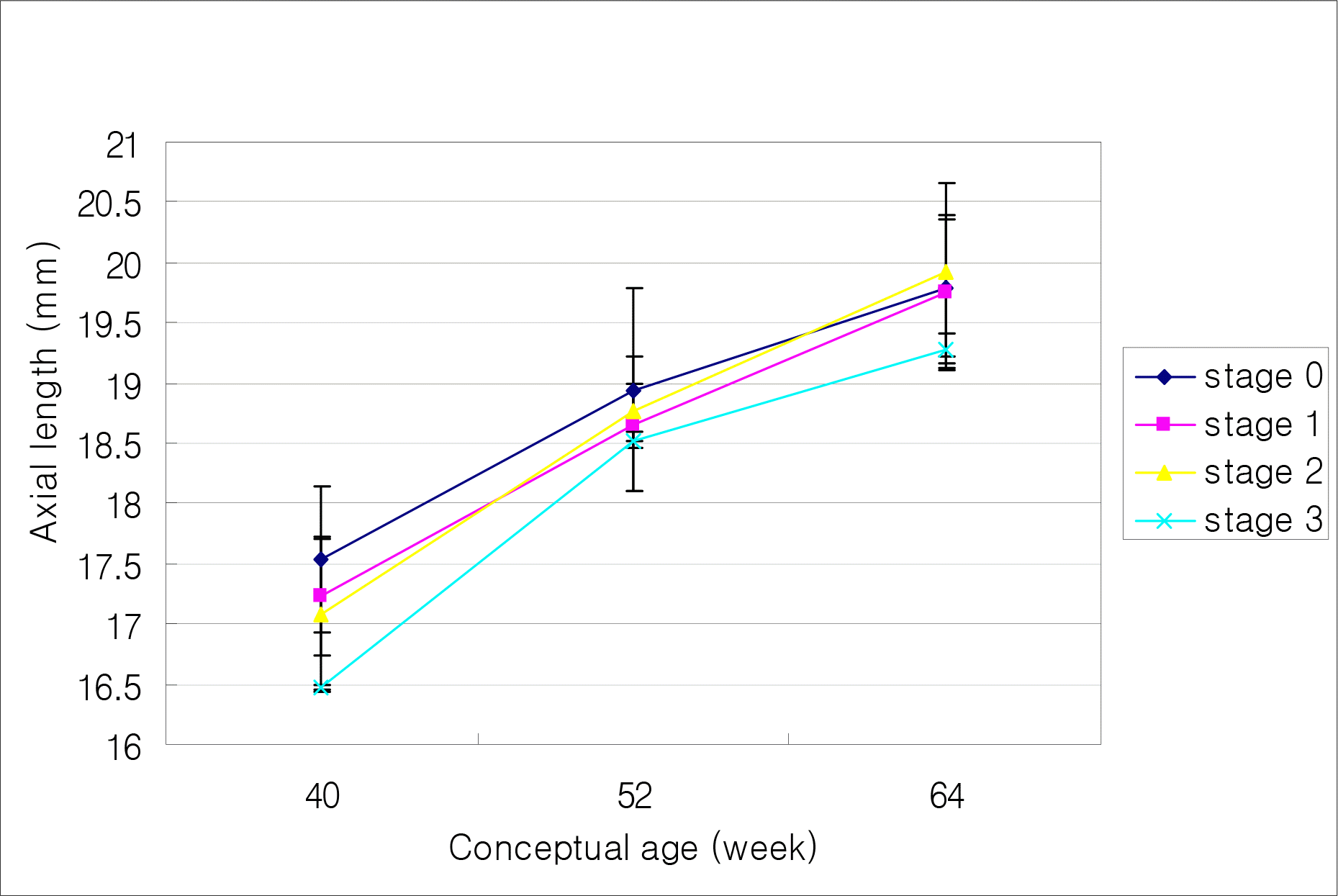
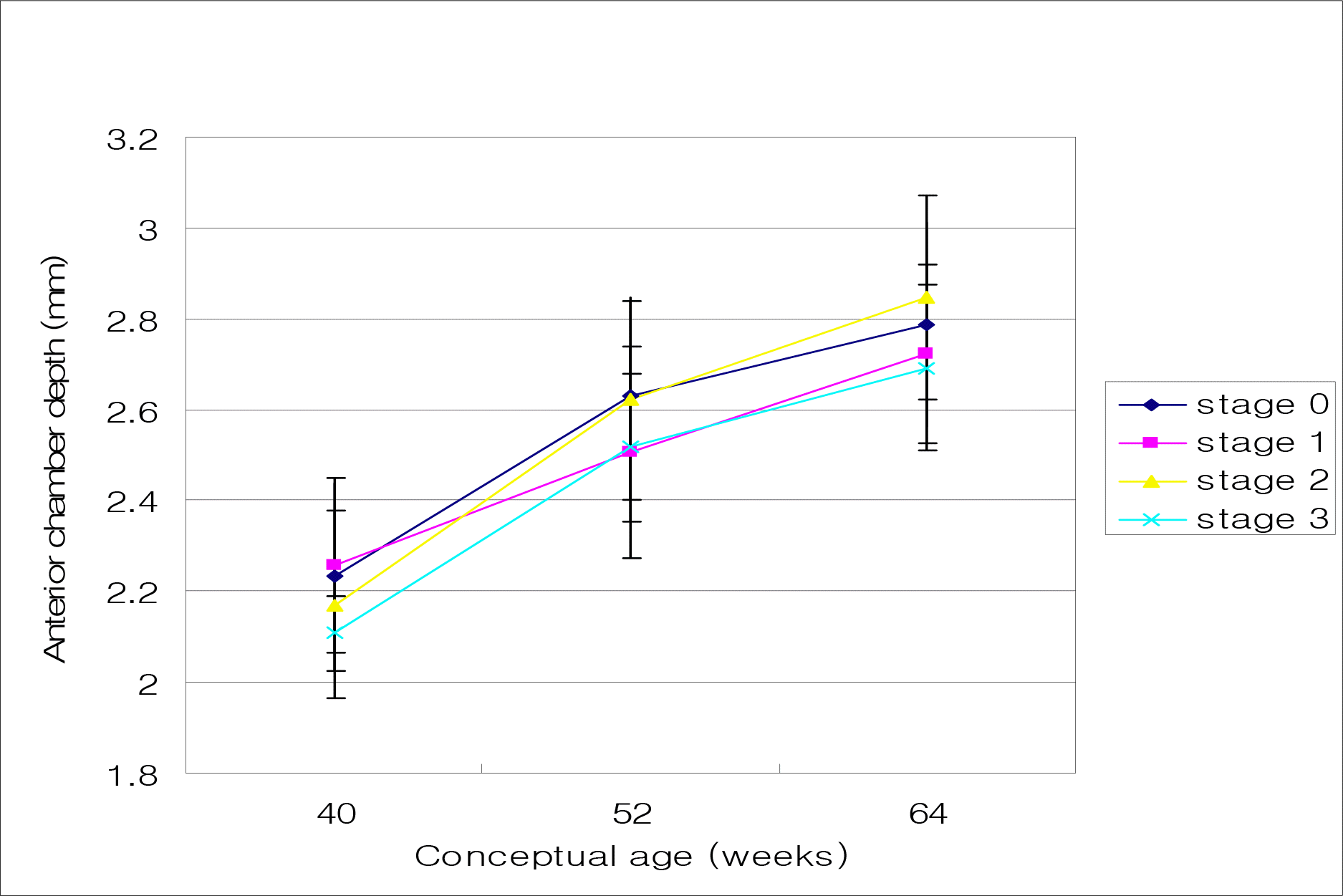
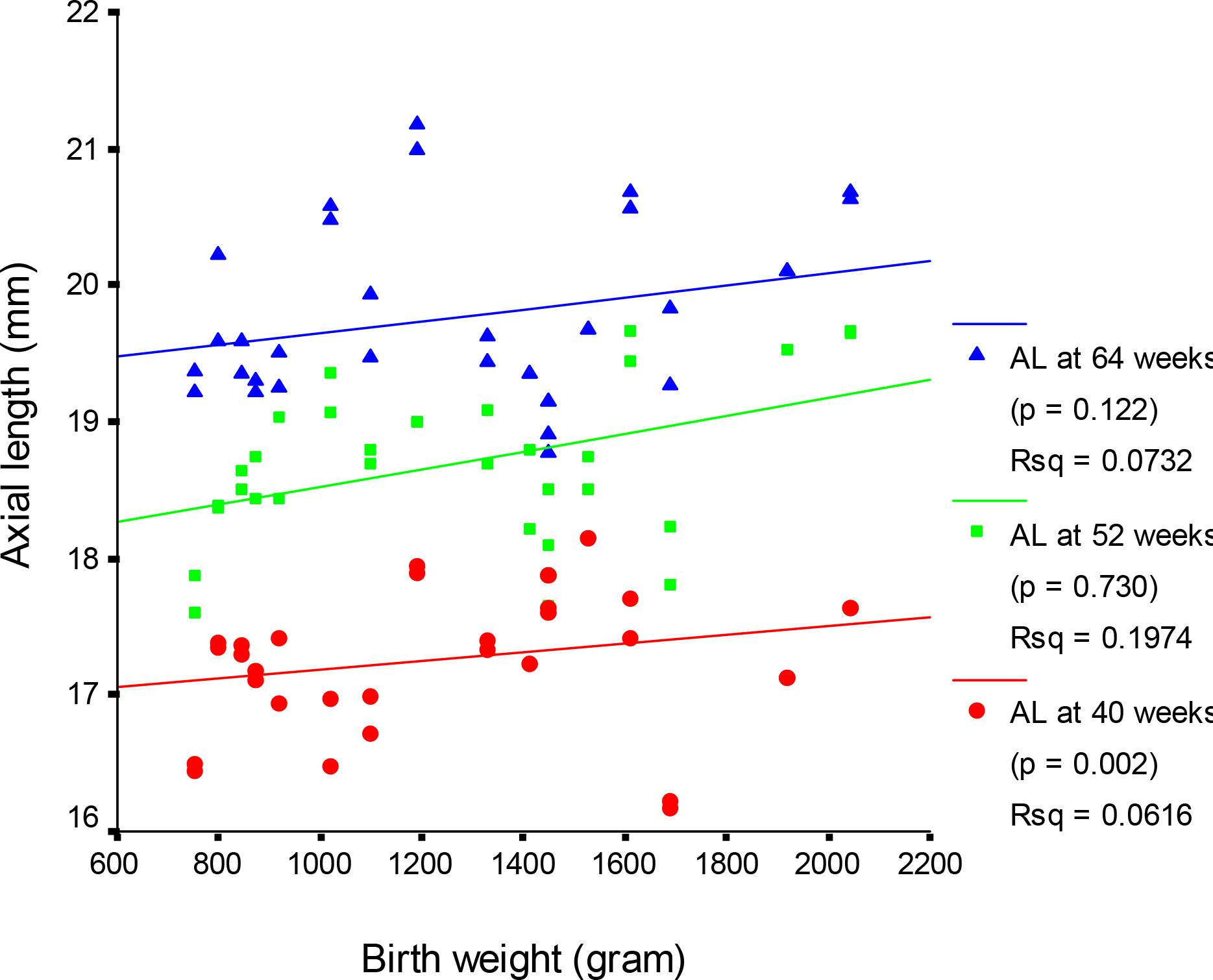
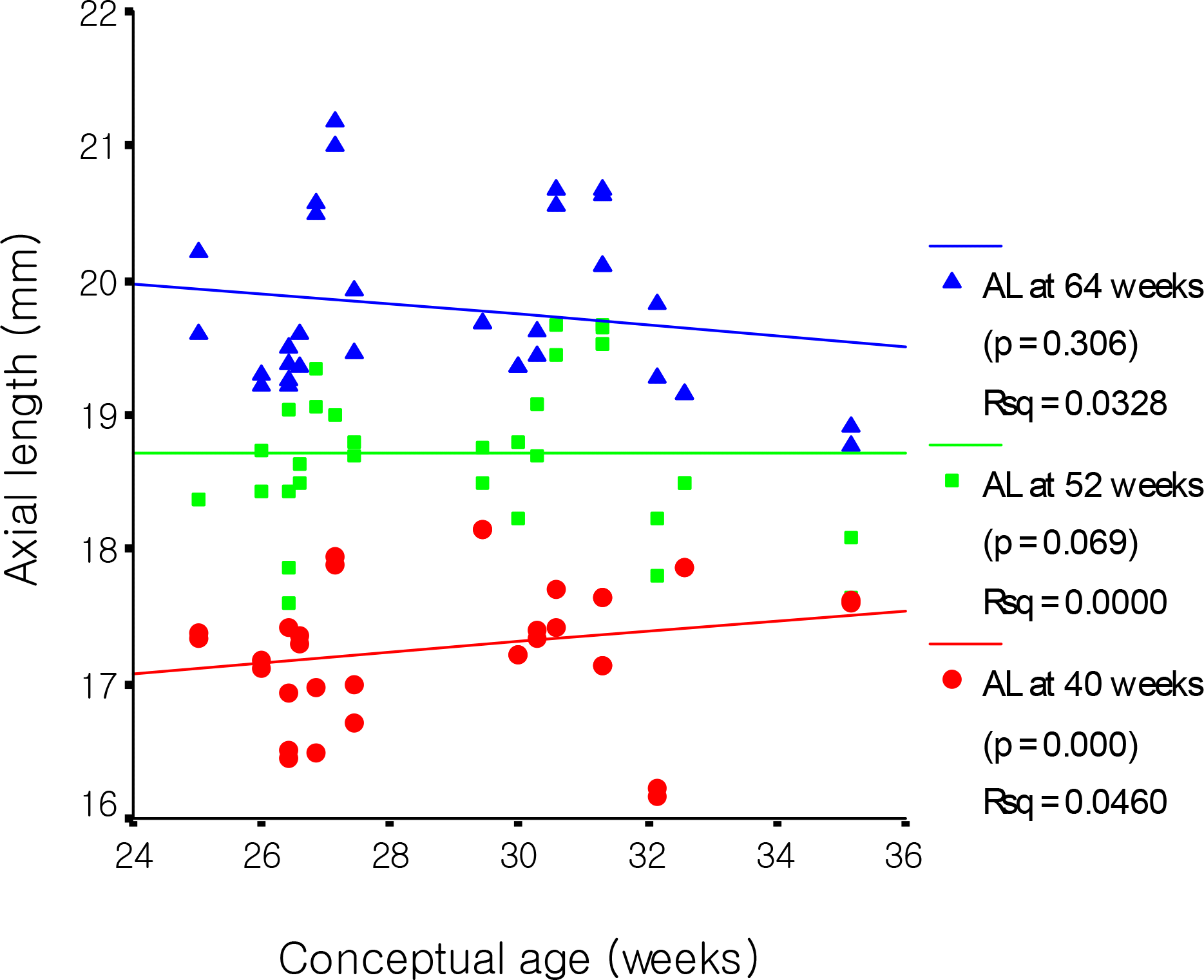
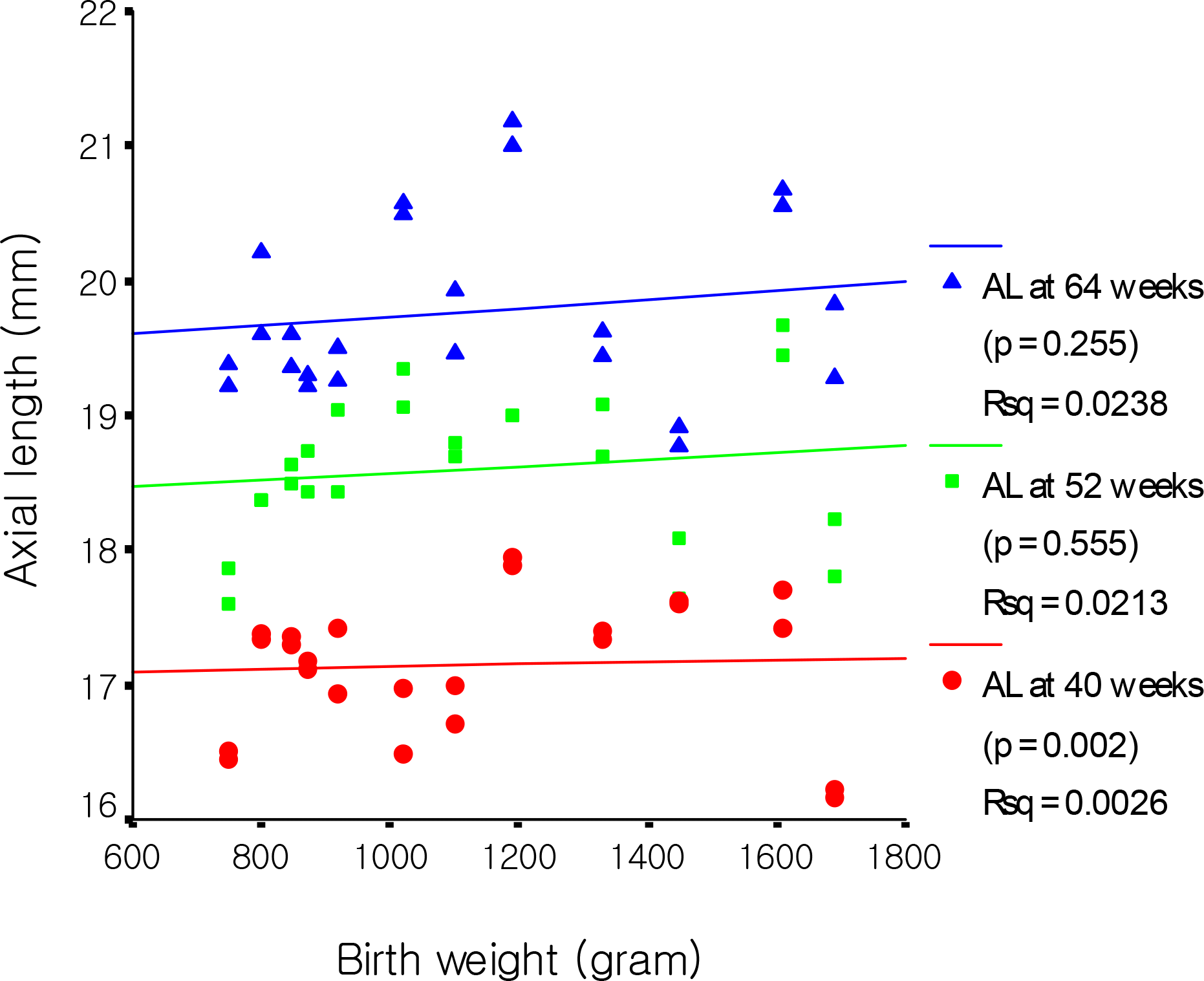
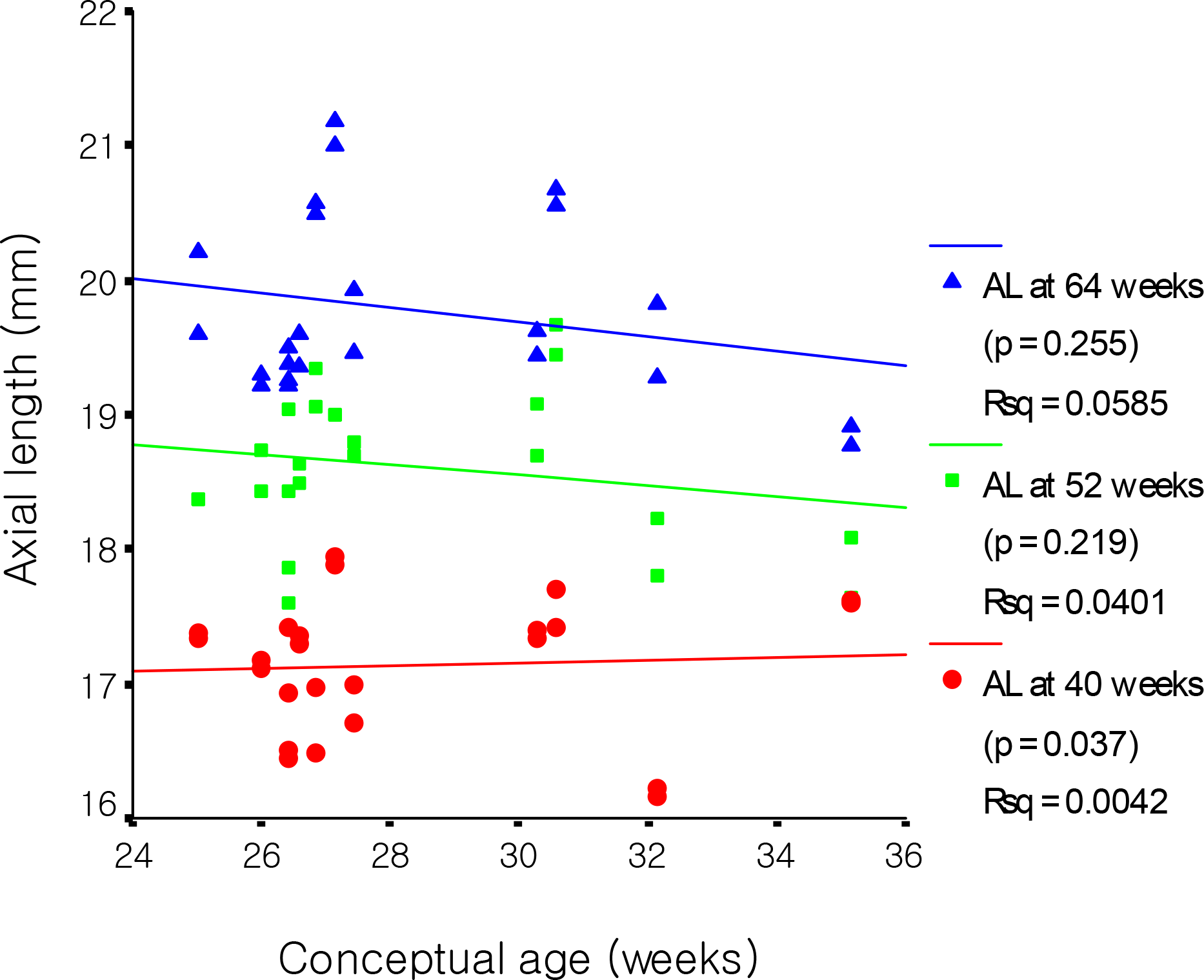
 XML Download
XML Download